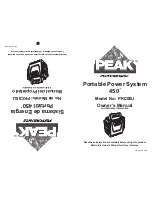
Step 2
Example 1
Example 2
Example 3
Number of people in
the vehicle (driver and
occupants)
5
3
1
Distribution of the
occupants
Front: 2
Rear: 3
Front: 1
Rear: 2
Front: 1
Weight of the occu-
pants
Occupant 1: 150 lbs
(68 kg)
Occupant 2: 180 lbs
(82 kg)
Occupant 3: 160 lbs
(73 kg)
Occupant 4: 140 lbs
(63 kg)
Occupant 5: 120 lbs
(54 kg)
Occupant 1: 200 lbs
(91 kg)
Occupant 2: 190 lbs
(86 kg)
Occupant 3: 150 lbs
(68 kg)
Occupant 1: 150 lbs
(68 kg)
Gross weight of all
occupants
750 lbs (340 kg)
540 lbs (245 kg)
150 lbs (68 kg)
Step 3
Example 1
Example 2
Example 3
Permissible load (max-
imum gross vehicle
weight rating from the
Tire and Loading Infor-
mation placard minus
the gross weight of all
occupants)
1500 lbs (680 kg)
Ò
750 lbs (340 kg) =
750 lbs (340 kg)
1500 lbs (680 kg)
Ò
540 lbs (245 kg)
=960 lbs (435 kg)
1500 lbs (680 kg)
Ò
150 lbs (68 kg) =
1350 lbs (612 kg)
Vehicle identification plate
Even if you have calculated the total cargo
carefully, you should still make sure that the
gross vehicle weight rating and the gross axle
weight rating are not exceeded. Details can be
found on the vehicle identification plate on the
B-pillar on the driver's side of the vehicle
(
Y
page 316).
Permissible Gross Vehicle Weight Rating
(GVWR): the gross weight of the vehicle, all
passengers, load and trailer load/noseweight
(if applicable) must not exceed the permissible
gross vehicle weight.
Gross Axle Weight Rating (GAWR): the maxi-
mum permissible weight that can be carried by
one axle (front or rear axle).
To ensure that your vehicle does not exceed
the maximum permissible values (gross vehi-
cle weight and maximum gross axle weight rat-
ing), have your loaded vehicle (including driver,
occupants, cargo, and full trailer load if appli-
cable) weighed on a suitable vehicle weigh-
bridge.
318
Loading the vehicle
Wheels
and
tires
















































